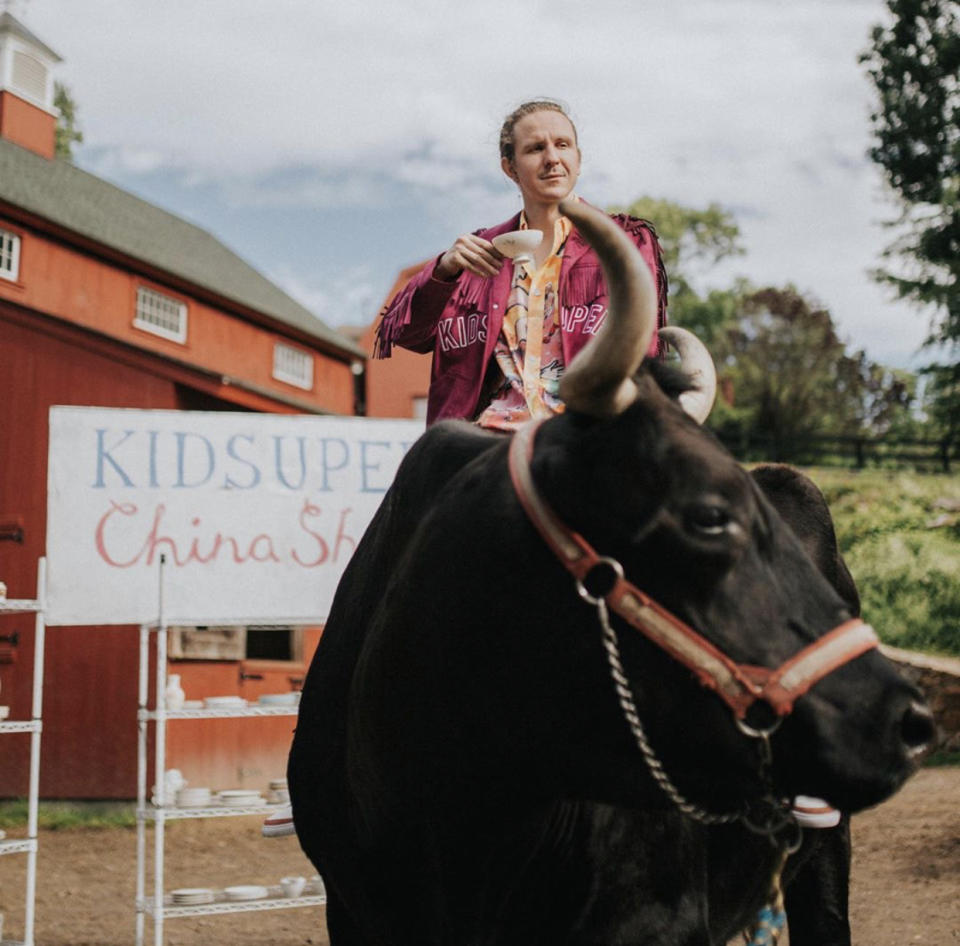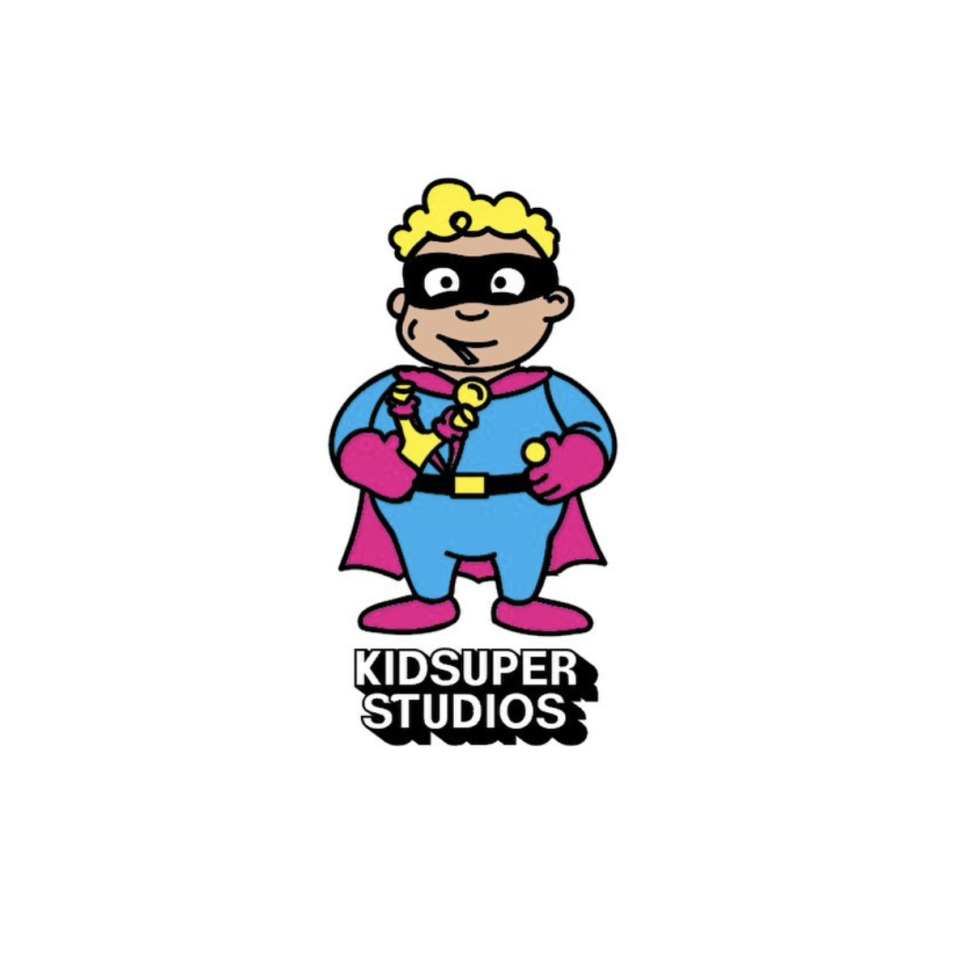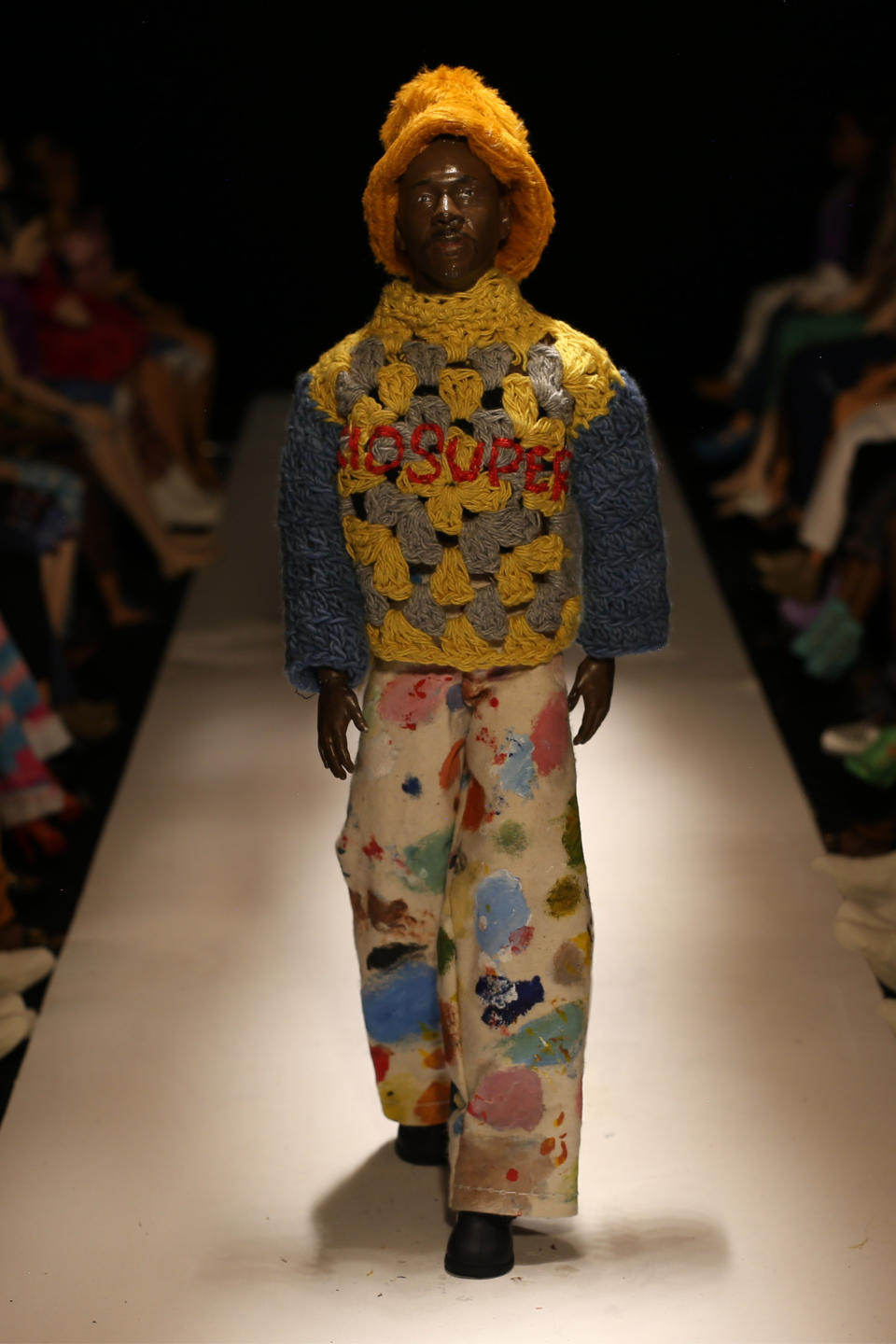Is KidSuper Fashion’s Next Breakthrough Star?

Colm Dillane was 45 minutes late for his interview and cover shoot. His cast of real-life friends/models showed up about 20 minutes before he did and used their waiting time to sing his praises while they rolled joints and watched the fountain spout water in the center of Washington Square Park on a summer afternoon.
“Colm is out of his f–king mind, but he’s a genius,” said Hollywood Anderson, a singer Dillane discovered in the subway about five years ago.
More from WWD
Apparently the fashion community agrees.
Dillane, the 29-year-old founder and designer of KidSuper, is on the verge of being the industry’s latest breakout star. The New York City native, who attended Brooklyn Tech high school and New York University before embracing fashion full-time, started making T-shirts when he was in high school. Over the last few years, he has shown his collection during Paris Fashion Week, collaborated with Puma, sells at Dover Street Market, Ssense, Selfridges, Luisa Via Roma and other high-profile stores, and is a finalist for the LVMH Prize, which will be awarded in September.

Despite his success, Dillane is still the same creative kid who was born in New York, lived all over the world while his Spanish-born mother and Irish father sought to establish roots, and who briefly played professional soccer in Brazil. But it’s his collection of art-inspired streetwear that has put him on the map, attracting enough attention — and sponsors — that he’s preparing to move from his gritty South Williamsburg creative studio into a larger space this fall.
When Dillane finally arrives for his appointment, his charm and enthusiasm immediately wins everyone over. And he quickly attracts an audience of passersby who aren’t shy about asking who he is and the name of the brand. “What is it?” asked one guy walking by with his border collie. “It’s really cool.”
Dillane’s collection is nothing if not cool — and completely representative of who he is as a person. That includes its name: “I started when I was young, thinking I could do anything and everything. KidSuper encompassed that feeling and represented who I was and who I wanted to be.
“I grew up 10 blocks from here, on Grand and Thompson.” he continued, pointing downtown from the Washington Square arch. But between the ages of three and 12, the family moved every two years, with stops in Chicago, Mexico and Wisconsin. “In eighth grade, I moved back here from Beloit, Wisc., which is not even unfashionable — fashion’s not even a thing there. You go to Walmart to buy your groceries, your bike and your clothes. Fashion didn’t determine your coolness. Then I get thrown into high school in Brooklyn where fashion determines your full coolness.”
It was there that Dillane first dabbled in apparel alongside some of his high school buddies. “Instead of buying Supreme or Bape or Ten Deep, I said, let me start making my own clothes. My mom’s an artist and she taught me to draw so we were just drawing on T-shirts and then we became known as the T-shirt kids. If you wanted a T-shirt for your birthday, we made it.”
The success they discovered among their peers made them think big. “We said, ‘We should create a brand, we’re going to be the next Supreme or Ten Deep.’ What’s great about New York is that it makes things feel tangible. We knew Supreme and Ten Deep and all these streetwear brands we were fans of had started in New York, so we thought we can do it, too. When you’re in Wisconsin, you don’t feel like you can do it.”
At that time his underground T-shirt company was being created by a consortium. “There were 10 of us involved, which is about nine more than you need. There were constant arguments, but we were 16 years old. So I learned at a young age that you need a captain vision. Even if it’s not the best, you need it to get things moving.”
So after taking a year to play professional soccer in Brazil, where he continued to create T-shirts — “There’s a lot of down time” — Dillane came back to New York to attend NYU, where he majored in math. “I’m smart-ish,” he admitted. “I went to Brooklyn Tech, which is a specialized high school and majored in math, and I’m not a quitter, so I had to see it through.”
He also applied the skills he had acquired as a teenager to hone his craft.
“The good thing is I failed a lot as a little kid,” he said. “I started so young. So it gave me time to fail. I have a lot of friends trying things now and they’re too preoccupied with failing that it kind of stops them from giving 100 percent. But when you’re young, there’s no pressure. And also, no one is going to say, ‘You’re a good designer, but your T-shirt when you were 16 was really bad.’ No one cares about that. It actually adds to the story.”
If the fashion industry hadn’t come calling, Dillane said he might have applied his degree to mechanical engineering to create robots, or something along those lines. But those T-shirts kept interfering. As a freshman, he met a web designer, which he refers to as his “big a-ha moment. Steve Wozniak meets Steve Jobs,” he said. “I said we’re going to be billionaires. It was my first time being able to sell to people that I didn’t meet.”
By his second year at NYU, he had converted his dorm room into a store, which was a no-no. “I kind of got kicked out,” he admitted sheepishly. “They didn’t like random people coming in to purchase clothing. And they also didn’t like shipping and I was shipping a lot in and out from the dorm. But it inspired me — I can’t put a store in a dorm but what if I put a dorm in a store?”
He decamped back to Brooklyn, where he found a space in the back of a store where he could live and work at his T-shirt business while still attending classes in Manhattan. Soon after, he hosted his first event and people lined up down the block to come into the store and buy pieces from this new KidSuper brand.

Dillane attracted the attention of Converse, which paid him $5,000 to do an ad campaign. He used the money to convert the store into a “creative space,” or the next “Andy Warhol Factory,” complete with a recording studio, a sewing area, a photo studio and a turf-covered backyard.
“This is going to be a place that I wish existed when I was in high school,” he recalled saying at the time.
It worked. One artist, Russ, used the studio to record a platinum-selling record, another started a jewelry business, and Dillane himself took the plunge into making music videos in which his clothes would be featured, including one for Russ that has had 10 million views on YouTube. “That kind of elevated the brand from streetwear, which can box you in to hoodies and T-shirts, and people started seeing me more as an artist.”
Dillane actually views KidSuper as “a canvas” for his art. “If I draw this, you’re not going to buy my painting, but you’re potentially going to buy a T shirt. So that’s how I got into it. And then as I progressed, I asked, ‘How do you stand out? Everyone makes the same clothes.’ So for me, every piece was going to have a piece of KidSuper art, or a story or a connector. KidSuper makes statement pieces. If you want a black T-shirt, I’m not the guy.”
His process is also different from other designers. “I love the video process so much and am inspired by what a person would wear for a scene. Everything is kind of inspired by the vision and then you build back from the vision. How do you translate that into painting and then add that painting to clothes? So that’s usually how it works.”
While his process may be unconventional, his work was good enough to finally find a home on the official Paris Fashion Week calendar after two seasons showing independently.
Although his hope of presenting alongside Hermès and Louis Vuitton began as a pipe dream, he said the support of his community made him go all-in. “They didn’t doubt me, so I said, there’s no way I’m going to doubt myself.” So while he wasn’t accepted onto the official calendar at first, he found a space, had his parents walk in the show and solicited his best friend from Wisconsin to be the stylist. “Which basically meant he handed me clothes,” he said with a laugh. “But it was a real family thing.”
To maintain the momentum, he came back to New York and created an installation where he took “piles” of donated clothes, put in 50 sewing machines and invited people to create their own outfits. This also ticked the sustainability box — an important topic for the designer.
“I wanted to address sustainability in a way that was tangible,” he said. “I wanted to do something that you could feel with your own hands. Singer donated some sewing machines, I created a workshop where people, with my guidance, could remake old donated clothing into a full new collection, ultimately leading to a fashion show: Recycling: A Fashion Show. Attendees were not only allowed to experience the process, but they became makers themselves and were inspired to rework and remake their own items.”
Dillane said the big issue with sustainability is that it “feels so unattainable or impossible to achieve from day-to-day use. Sustainability in fashion is such a rabbit hole,” he continued. “It is so hard to know exactly where clothes are actually being made, shipped, dyed etc. And if we are going to be completely honest with ourselves the best thing a brand can do for sustainability is not make clothes. But I think this mental spark that changes someone from an observer to a maker is the epiphany we need to get people to actually start thinking sustainable. The power is in our hands.”
Recycling: A Fashion Show, which drew 3,000 people — “There was a line down the block. It was a huge party” — also addressed another issue he sees in the industry.
“I always thought art shows and fashion shows are so boring because you didn’t get to participate. So I was like, ‘How cool would it be if you were actually part of the show?’ Thirty people came every day to work in the factory.”
The next season, he once again tried to get on the official Paris calendar, but was rejected, which he took as inspiration. “I printed the rejection letter on a dress, and it was the first look of my second show,” he said.
His big break came with the spring 2021 season, when he was finally given a slot on the official calendar. “Then COVID-19 hit,” he said, which was actually a blessing in disguise. “I was so happy because I would not have been able to afford it, mentally or physically,” he said of having to do a live show.

Instead, he decided to use his skills in making videos to create a virtual “doll fashion show” using Claymation figures and stop-motion video. The $4,000 he spent to create the show turned out to be the hit of the season and caught the eye of Rei Kawakubo, founder of Comme des Garçons, who added the brand to her Dover Street Market stores.
The momentum around the label continued to build and for his spring 2022 show during Paris Fashion Week, which was still virtual, Dillane set up a booth in Washington Square Park and asked people, “What do you want to do before you die?” He created a film helping people — dressed in KidSuper, of course — fulfill those dreams, which included skydiving, reuniting with their families and traveling to Paris.
Dillane’s outside-of-the-box thinking and trend-right collections also caught the attention of the LVMH judges, who selected him, along with American designers Christopher John Rogers and Conner Ives, as finalists for the LVMH Prize for Young Designers. Dillane said this is the first “official” acknowledgment that he’s been accepted by the mainstream fashion industry. And he’s gunning for the win.
“I’m super competitive and I love this kind of head-to-head competition.”
He said because the judging will be mainly virtual this year, brands were asked to create booklets to showcase their lines. “So I looked at everyone else’s before submitting mine, and I went above and beyond.”
If he wins in September — which would come with a 300,000 euro cash prize and one year of mentorship — it will help him further carve out a niche in the fashion world. But if he doesn’t, that’s OK, too.
”I already have the support of the cultural world,” he said. “I had to gain that support to even get visually accepted by fashion. Everyone else in the competition comes from a fashion background. Since it was so hard for me to break into the fashion world, I had to create this community and culture. And that’s why I think the brand actually stands for something.”
Community continues to be at the core of KidSuper. “Why are you making clothes?” he asked. “If it’s not for the community, I just don’t understand. Every item of clothing already exists; there’s no need for a new brand unless you’re going to change culture, influence people, support visions, try to collaborate.”
He’s certainly not in it for the money. “All the money that I get, I just spend it on cool s–t that I want to do. The clothes just fund the ideas. It was never anything else.”
His community will also benefit from his newest project — his plan is to build a larger, more elevated “community center” in New York, which will have a soccer field, recording studio, work spaces and a factory and deli that will be open 24 hours a day. The space will be sponsored by Puma, which has collaborated with Dillane in the past, as well as Jägermeister, and others.
As a result of these deep-pocketed sponsors, Dillane sees a bright future for KidSuper. “If I had never connected to sponsorship, I would have never been able to do what I did,” he said. “People like Jägermeister and Puma can’t be authentic themselves because they’re too big. So they pay to get connected.”
Case is point is Reebok turning to Kerby Jean-Raymond or Louis Vuitton hiring Virgil Abloh as their creative directors. Is this a path Dillane would consider?
“I would 100 percent entertain the idea,” he said. “I would definitely do it for the experience. I’ve never had a team, I’ve never had an atelier, I’ve never worked within the rules of fashion. But I think I could succeed in that space. And it seems like it’s not that hard. You have so many people working for you. You just come in and said, ‘Yes, red’.”
If he does get hired by a big brand, he may have to stop posting naked pictures of himself on Instagram. “I’m really not naked that often,” he insisted. “But when I was little, I was always naked and free and I think it’s a good visual for freedom. And I think it’s also childish, which I like.
“How do you tell people who you are? Oh, wait, he’s running naked on the street. OK, I know what type of person he is.”
Naked or not, Dillane has big dreams for his nascent KidSuper brand. Not surprisingly, they revolve around his love of sports and street culture.
“I think KidSuper is going to be like the Red Bull of fashion. They have soccer teams. They have Formula One, which people think is unrelated to the beverage. But I think it’s similar with KidSuper. Instead of me spending a million dollars for that Calvin Klein poster, or a billboard on Houston Street, I’m just going to buy a third division soccer team, and they’re going to wear KidSuper. And it’s going to be called KidSuper FC.”
Launch Gallery: Is LVMH Prize Winner KidSuper Fashion’s Breakthrough Star?
Sign up for WWD's Newsletter. For the latest news, follow us on Twitter, Facebook, and Instagram.

